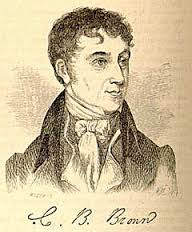The third work by Charles Brockden Brown that I will look at is Edgar Huntly, published in the same year as the massive Arthur Mervyn. As in Arthur Mervyn and the earlier work Wieland, Brown is interested in defining an American culture as opposed to Europe. Edgar Huntly is different in that while the previous two works looked to the corrupting influences of the Old World and the city, this work considered the American frontier as a space of alternatives. We are not left to sympathize with the frontier entirely, since it is as bizarre, violent, and corrupting as the European-style city, but it is clearly an American gothic in the “wilderness.” With Edgar Huntly, Brown achieved a clear independence from the European gothic. Brown clearly states this as his goal in the preface to the novel.
America has opened new views to the naturalist and politician, but has seldome furnished themes to the moral painter. That new springs of action, and new motives to curiosity should operate; that the field of investigation, opened to us by our own country, should differ essentially from those which exist in Europe, may be readily conceived. The sources of amusement to the fancy and instruction to the heart, that are peculiar to ourselves, are equally numerous and inexhaustible. It is the purpose of this work to profit by some of these sources; to exhibit a series of adventures, growing out of the condition of our country, and connected with one of the most common and most wonderful disease or affections of the human frame. (641)
The novel begins with Edgar Huntly recovering from the death of his friend Waldegrave. At the same time he sees a man digging a grave in the woods, while sleepwalking. He eventually confronts this man—who turns out to be the red herring villain of the story Clithero (of course a foreigner)—about his actions. Clithero tells the story about how he killed an vile man in Ireland who tried to rob him before moving to America. So he is a murderer but not of Waldegrave. After sleepwalking himself (an affliction Huntly is not aware he has yet), he wakes up deep in the forest. The wilderness seems to drive him to a murderous rampage of his own, climaxing in the liberation of a white woman captured by the local Indians. In the process of freeing her, he kills several Indians, crossing clearly into the boundary of savagery. At one point he meets Clithero who retreated to the forest after confessing his past crimes to Huntly. He also descends into savagery, but retains some degree of human solidarity seen in the aid he gives to Huntly. In the end, sacrifice and benevolence and solidarity help the characters survive what is a truly horrific situation.
Much in this work is familiar to readers of Brown’s other novels: the mysterious and possibly malevolent stranger, a lost past, a woman’s virtue under threat, and locals saturated with the feeling of the uncanny. What is very new is that the forest is the site of so much of the action. For Brown, it is also a space of dangerous liberty, crystalized with stories of Indian violence, but also of whites going native. At one point, the wilderness seems to change someone into a beast.
My eye was not caught by movements which appeared like those of a beast. In different circumstances, I should have instantly supposed it to be a wolf, or panther, or bear. Now my suspicions were alive on a different account, and my startled fancy figured to itself nothing by an human adversary. . . . He moved upon all fours, and presently came near enough to be distinguished. His disfigured limbs, pendants from his ears and nose, and his shorn locks, were indubitable indications of a savage.” (814)
The titular character’s encounter with an Indian woman named Queen Mab is to me particularly memorable. She is described as fully of nature, and therefore a symbolic danger to the Edgar Huntly (she is too old to pose much a danger, she is presented as part of the uncanny wilderness and does help Indians commit violence against whites), but she is also entirely free holding domino only over animals and being servant of no one.
Her only companions were three dogs, of the Indian or wolf species. These animals differed in nothing from their kinsmen of the forest, but in their attachment and obedience to their mistress. She governed them with absolute sway: they were her servants and protectors, and attended her person or guarded her threshold, agreeably to her directions. She fed them with corn and they supplied her and themselves with meat, by hunting squirrels, raccoons, and rabbits. (821)
The significant of Queen Mab cannot be overstated. Brown ended the novel with how Queen Mab “defied her oppressors” by aiding Indian raiders.
When looked at as part of Brown’s entire work, Americans are left in a rather uncomfortable position. Certainly the European influence, whether framed in family history, wealth, and urban society, is dangerous and a source of the uncanny. At the same time, the American wilderness is a dangerous and mysterious other taking American freedoms to their radical and dangerous limit. America must overcome both of these with virtue and benevolence. But is this not a very dangerous place to rest a people’s cultural heritage?
